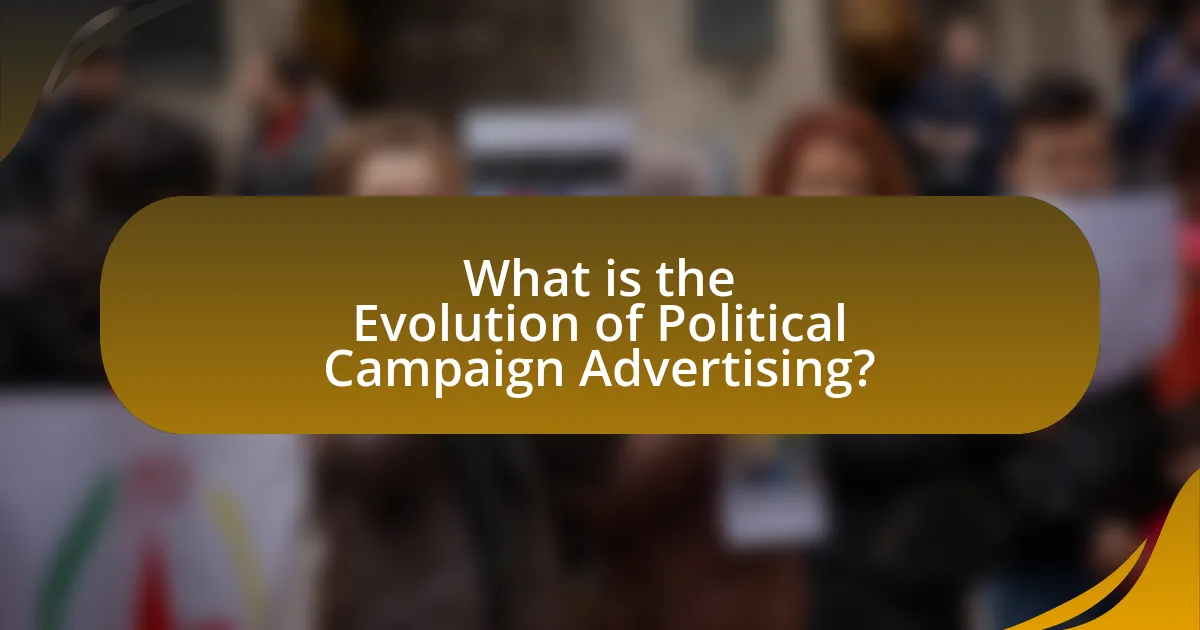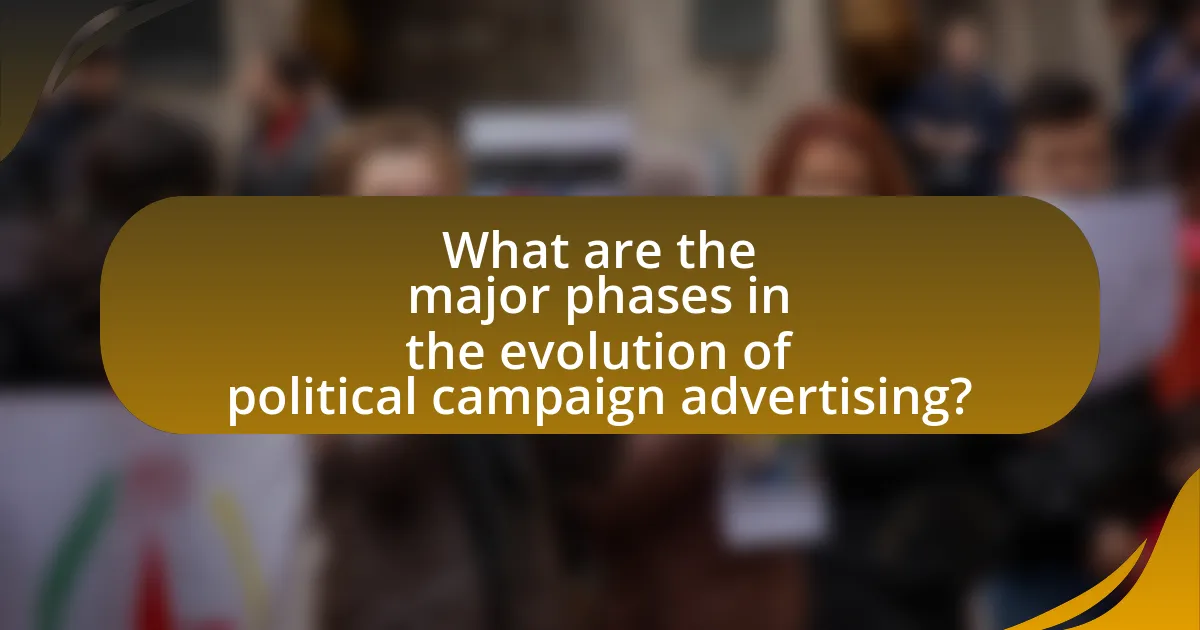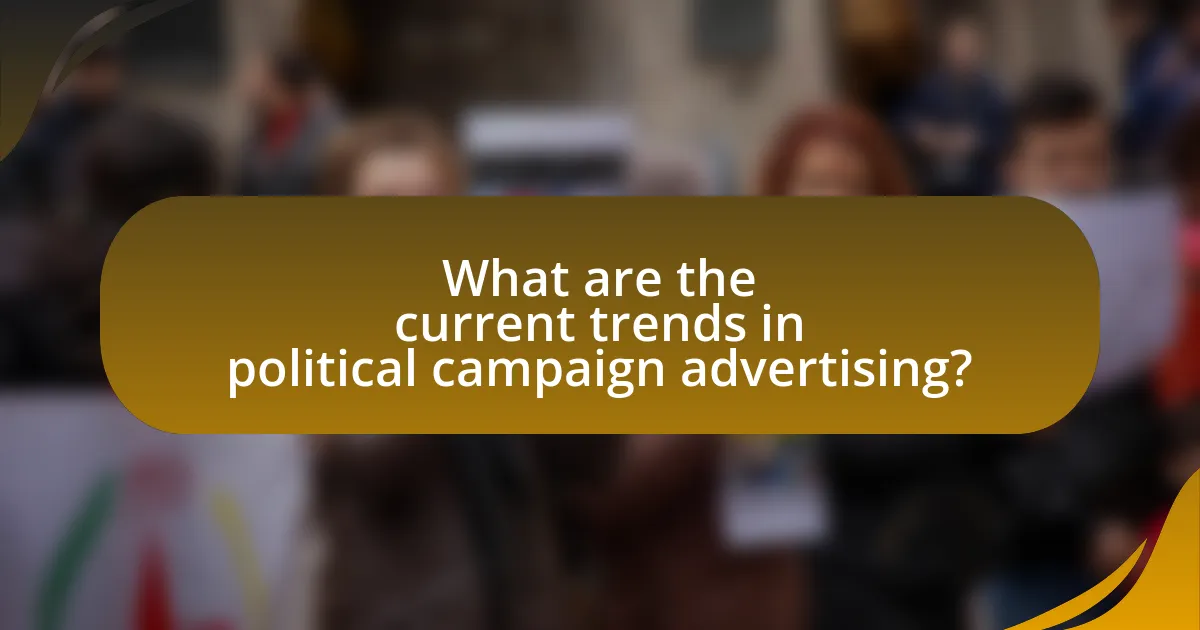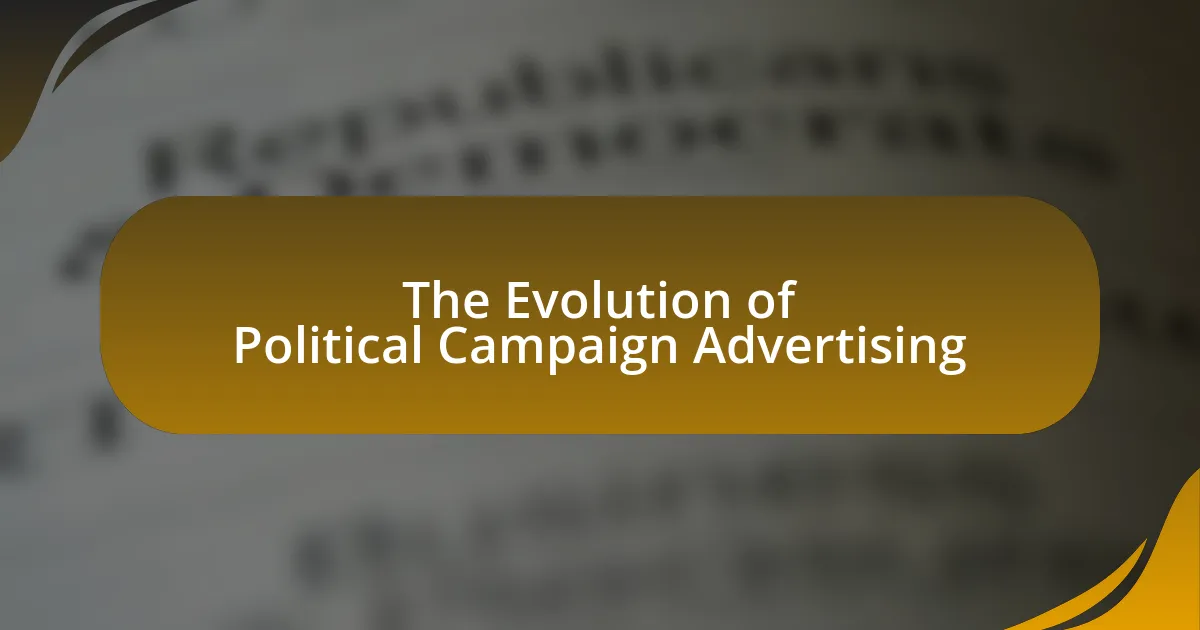The article examines the evolution of political campaign advertising, tracing its development from 19th-century print materials to contemporary digital strategies. Key milestones include the introduction of radio and television, which transformed how candidates communicated with voters, and the rise of the internet and social media, which enabled targeted advertising and real-time engagement. The article highlights the impact of technological advancements on campaign strategies, emphasizing the importance of data analytics and voter targeting in modern political advertising. Additionally, it addresses ethical considerations, regulations, and best practices that shape the current landscape of political communication.

What is the Evolution of Political Campaign Advertising?
The evolution of political campaign advertising has progressed from simple pamphlets and speeches in the 19th century to sophisticated digital strategies in the 21st century. Initially, candidates relied on printed materials and public speeches to communicate their messages, with the first notable use of mass media occurring during the 1920 presidential election when radio broadcasts began to play a significant role.
The introduction of television in the 1950s transformed political advertising, exemplified by Dwight D. Eisenhower’s successful use of television commercials in the 1952 election, which set a precedent for future campaigns. By the 2000s, the rise of the internet and social media platforms allowed for targeted advertising, enabling campaigns to reach specific demographics with tailored messages.
Data from the Pew Research Center indicates that as of 2020, 73% of Americans reported using social media, highlighting its importance in modern political advertising strategies. This evolution reflects a shift towards more interactive and personalized forms of communication, significantly impacting voter engagement and campaign effectiveness.
How has political campaign advertising changed over time?
Political campaign advertising has evolved significantly from traditional print and broadcast media to digital platforms and social media. Initially, campaigns relied on newspapers, pamphlets, and radio to reach voters, with the first televised presidential debate in 1960 marking a pivotal moment in visual advertising. The rise of the internet in the late 1990s introduced online ads, email campaigns, and targeted messaging, allowing campaigns to reach specific demographics more effectively. By 2020, social media platforms became central to campaign strategies, enabling real-time engagement and micro-targeting through data analytics. This shift reflects a broader trend towards personalization and immediacy in political messaging, as evidenced by the substantial increase in digital ad spending, which surpassed traditional media expenditures for the first time in recent elections.
What were the key milestones in the history of political campaign advertising?
The key milestones in the history of political campaign advertising include the introduction of the printing press in the 15th century, which allowed for the mass production of pamphlets and posters, significantly enhancing political communication. In the 19th century, the use of newspapers became prevalent, with candidates utilizing them for advertisements and editorials to shape public opinion. The advent of radio in the 1920s marked a transformative moment, enabling candidates to reach wider audiences through broadcasts. Television emerged in the 1950s, revolutionizing campaign strategies with visual storytelling and advertisements, exemplified by the 1960 Kennedy-Nixon debates, which highlighted the importance of image in politics. The rise of the internet in the late 1990s and social media in the 2000s further changed the landscape, allowing for targeted advertising and direct engagement with voters. Each of these milestones reflects significant shifts in how political messages are conveyed and received, shaping modern electoral strategies.
How did technological advancements influence political campaign advertising?
Technological advancements significantly transformed political campaign advertising by enabling targeted messaging and broader reach. The introduction of digital platforms, particularly social media, allowed campaigns to analyze voter data and tailor advertisements to specific demographics, increasing engagement and effectiveness. For instance, during the 2008 U.S. presidential election, Barack Obama’s campaign utilized data analytics to target voters through platforms like Facebook and Google, resulting in a reported increase in voter turnout among young people. Additionally, advancements in mobile technology facilitated real-time communication and fundraising, further enhancing campaign strategies. These changes illustrate how technology has reshaped the landscape of political advertising, making it more data-driven and interactive.
Why is understanding the evolution of political campaign advertising important?
Understanding the evolution of political campaign advertising is important because it reveals how strategies and technologies have shaped voter engagement and electoral outcomes over time. Historical shifts, such as the transition from print media to digital platforms, illustrate how campaigns adapt to changing communication landscapes. For instance, the rise of social media has transformed political advertising, allowing for targeted messaging that can influence public opinion more effectively than traditional methods. This evolution is evidenced by the significant impact of the 2008 Obama campaign, which utilized social media to mobilize voters and raise funds, setting a precedent for future campaigns. Analyzing these changes helps stakeholders comprehend the dynamics of modern political communication and the implications for democracy.
What impact does the evolution have on current political strategies?
The evolution of political campaign advertising significantly impacts current political strategies by shifting focus towards digital platforms and data-driven approaches. As traditional media consumption declines, political campaigns increasingly utilize social media and targeted online advertising to reach specific voter demographics. For instance, the 2020 U.S. presidential election saw campaigns allocate over 50% of their advertising budgets to digital platforms, reflecting a strategic pivot towards online engagement. This evolution allows for real-time feedback and adaptive messaging, enhancing voter outreach and engagement effectiveness.
How does historical context shape modern political advertising practices?
Historical context significantly shapes modern political advertising practices by influencing strategies, messaging, and media usage. For instance, the advent of radio and television in the mid-20th century transformed political campaigns, as candidates began to utilize these platforms for direct voter engagement, exemplified by John F. Kennedy’s televised debates in 1960, which highlighted the importance of image and presentation. Additionally, the rise of the internet and social media in the 21st century has further evolved advertising techniques, allowing for targeted messaging and real-time engagement, as seen in Barack Obama’s 2008 campaign, which effectively utilized social media to mobilize younger voters. These historical shifts demonstrate how past technological advancements and campaign strategies inform current practices in political advertising.

What are the major phases in the evolution of political campaign advertising?
The major phases in the evolution of political campaign advertising include the print era, the radio and television era, the cable and satellite era, and the digital era. The print era, which began in the 19th century, utilized newspapers and pamphlets to disseminate political messages. The radio and television era emerged in the mid-20th century, allowing candidates to reach broader audiences through audio-visual content. The cable and satellite era expanded options for targeted advertising, while the digital era, starting in the late 1990s, revolutionized campaign strategies with social media and online platforms, enabling real-time engagement and data-driven targeting. Each phase reflects advancements in technology and changes in voter behavior, shaping how political messages are communicated.
What characterized the early forms of political campaign advertising?
Early forms of political campaign advertising were characterized by simple, direct messaging primarily through printed materials such as pamphlets, posters, and newspapers. These advertisements focused on conveying the candidate’s key messages and platforms to the electorate, often utilizing slogans and imagery to attract attention. For instance, during the 1828 presidential campaign of Andrew Jackson, pamphlets and posters were widely used to promote his image as a man of the people, contrasting with his opponent John Quincy Adams. This approach laid the groundwork for future political advertising by establishing the importance of visual and textual elements in communicating political ideas effectively.
How did print media play a role in early political campaigns?
Print media significantly influenced early political campaigns by providing a platform for candidates to disseminate their messages widely. Newspapers and pamphlets served as primary tools for candidates to communicate their platforms, rally support, and shape public opinion. For instance, during the 1828 presidential campaign of Andrew Jackson, printed materials were extensively used to promote his image as a man of the people, contrasting with his opponent John Quincy Adams. This strategic use of print media helped to mobilize voters and establish a more direct connection between candidates and the electorate, marking a pivotal shift in political communication.
What were the first uses of radio and television in political advertising?
The first uses of radio and television in political advertising occurred during the 1920s and 1930s, with radio being utilized in the 1924 presidential campaign by candidates such as Calvin Coolidge. This marked a significant shift in how political messages were disseminated to the public. Television followed suit, with its first notable political advertisement airing in 1952 during the Eisenhower campaign, which featured the famous “Eisenhower Answers America” spot. These early uses of radio and television allowed candidates to reach a broader audience and engage voters in new ways, fundamentally changing the landscape of political campaigning.
How did the digital age transform political campaign advertising?
The digital age transformed political campaign advertising by enabling targeted messaging and real-time engagement with voters. Campaigns now utilize data analytics to identify specific demographics and tailor advertisements to individual preferences, significantly increasing the effectiveness of outreach efforts. For instance, the 2008 Obama campaign effectively used social media platforms and data-driven strategies to mobilize voters, resulting in a historic voter turnout. Additionally, digital advertising allows for immediate feedback and interaction, fostering a two-way communication channel between candidates and constituents, which was not possible in traditional media formats.
What are the key features of online political advertising?
The key features of online political advertising include targeted messaging, data analytics, and interactive engagement. Targeted messaging allows campaigns to reach specific demographics based on factors such as age, location, and interests, enhancing the relevance of the advertisements. Data analytics enables campaigns to track user engagement and optimize ad performance in real-time, leading to more effective strategies. Interactive engagement, through formats like polls and social media interactions, fosters a two-way communication channel between candidates and voters, increasing voter involvement. These features collectively enhance the efficiency and impact of political campaigns in the digital landscape.
How do social media platforms influence political campaign strategies?
Social media platforms significantly influence political campaign strategies by enabling targeted advertising and real-time engagement with voters. Campaigns utilize data analytics to identify specific demographics and tailor messages that resonate with those groups, enhancing voter outreach and mobilization. For instance, during the 2016 U.S. presidential election, the Trump campaign effectively used Facebook’s advertising tools to reach undecided voters, resulting in a reported 2.5 million additional votes. This demonstrates how social media not only amplifies campaign messages but also allows for strategic adjustments based on immediate feedback and engagement metrics.

What are the current trends in political campaign advertising?
Current trends in political campaign advertising include increased use of digital platforms, targeted advertising through data analytics, and a focus on authenticity and transparency. Digital platforms, such as social media, have become primary channels for reaching voters, with campaigns allocating significant budgets to online ads. According to a report by the Pew Research Center, 69% of Americans use social media, making it a crucial medium for engagement. Targeted advertising leverages data analytics to tailor messages to specific demographics, enhancing voter outreach effectiveness. Furthermore, candidates are prioritizing authenticity, often sharing personal stories and behind-the-scenes content to build trust with voters, as evidenced by the rise of influencer partnerships in campaigns.
How are data analytics shaping political campaign advertising today?
Data analytics are significantly shaping political campaign advertising today by enabling targeted messaging and optimizing ad spend. Campaigns utilize data analytics to analyze voter behavior, preferences, and demographics, allowing them to tailor advertisements to specific audiences. For instance, the 2020 U.S. presidential election saw campaigns leveraging data from social media platforms and voter databases to create personalized ads that resonated with individual voters, resulting in higher engagement rates. According to a study by the Pew Research Center, 62% of voters reported seeing political ads that were relevant to their interests, demonstrating the effectiveness of data-driven strategies in reaching and influencing potential voters.
What role does voter targeting play in modern campaigns?
Voter targeting plays a crucial role in modern campaigns by enabling candidates to identify and engage specific demographics that are most likely to support them. This strategic approach allows campaigns to tailor their messages and outreach efforts to resonate with particular voter segments, increasing the efficiency and effectiveness of their advertising. For instance, data analytics and voter profiling techniques, such as micro-targeting, have been employed to analyze voter behavior and preferences, leading to more personalized campaign strategies. According to a study by the Pew Research Center, 62% of voters reported receiving campaign messages that were specifically tailored to their interests, demonstrating the impact of targeted campaigning on voter engagement and turnout.
How do campaigns measure the effectiveness of their advertising efforts?
Campaigns measure the effectiveness of their advertising efforts primarily through metrics such as return on investment (ROI), engagement rates, and conversion rates. These metrics provide quantifiable data that helps campaigns assess how well their advertisements resonate with the target audience. For instance, a study by the American Association of Political Consultants found that campaigns utilizing digital advertising can track user interactions, leading to a more precise evaluation of ad performance. Additionally, surveys and focus groups are often employed to gather qualitative feedback, further enhancing the understanding of an ad’s impact.
What ethical considerations arise in political campaign advertising?
Ethical considerations in political campaign advertising include truthfulness, transparency, and the potential for manipulation. Campaigns must ensure that their advertisements do not mislead voters by presenting false information, as this undermines democratic processes. For instance, the Federal Election Commission mandates that all campaign ads disclose their funding sources, promoting transparency. Additionally, the use of emotional appeals or fear tactics can manipulate public perception, raising ethical concerns about the integrity of the electoral process. Research indicates that misleading advertisements can significantly impact voter behavior, highlighting the importance of ethical standards in maintaining a fair political landscape.
How do misinformation and disinformation affect political advertising?
Misinformation and disinformation significantly distort political advertising by misleading voters and shaping public perception. Political advertisements that contain false information can create confusion, erode trust in candidates, and manipulate electoral outcomes. For instance, a study by the Pew Research Center found that 64% of Americans believe that fabricated news stories cause confusion about the basic facts of political issues. This manipulation can lead to the spread of negative narratives about opponents, ultimately influencing voter behavior and election results.
What regulations govern political campaign advertising practices?
Federal and state regulations govern political campaign advertising practices, primarily through the Federal Election Commission (FEC) and various state election boards. The FEC enforces laws that require transparency in campaign financing, mandating that candidates disclose their funding sources and expenditures. Additionally, the Bipartisan Campaign Reform Act of 2002, also known as McCain-Feingold, restricts the use of soft money in federal elections and regulates the timing and content of political advertisements. These regulations aim to ensure fair competition and prevent corruption in the electoral process.
What best practices should campaigns follow in political advertising?
Campaigns should follow best practices in political advertising by ensuring transparency, targeting the right audience, and utilizing data analytics effectively. Transparency builds trust with voters; for instance, disclosing funding sources and ad sponsors can enhance credibility. Targeting the right audience involves using demographic and psychographic data to tailor messages, which has been shown to increase engagement and conversion rates. Effective use of data analytics allows campaigns to measure ad performance and adjust strategies in real-time, leading to more efficient use of resources. According to a study by the Pew Research Center, campaigns that leverage data-driven strategies see a significant increase in voter outreach effectiveness.
How can campaigns effectively engage with their target audience?
Campaigns can effectively engage with their target audience by utilizing targeted messaging and data-driven strategies. By analyzing demographic and psychographic data, campaigns can tailor their messages to resonate with specific groups, ensuring relevance and increasing the likelihood of engagement. For instance, a study by the Pew Research Center found that personalized content significantly boosts user interaction rates, demonstrating that campaigns that adapt their messaging based on audience insights achieve higher engagement levels.
What strategies can enhance the credibility of political advertisements?
To enhance the credibility of political advertisements, employing fact-checking and transparency strategies is essential. Fact-checking ensures that claims made in advertisements are accurate and verifiable, which builds trust among viewers. For instance, organizations like PolitiFact and FactCheck.org provide independent verification of political statements, which can be referenced in advertisements to substantiate claims. Transparency involves disclosing funding sources and the motivations behind the advertisement, allowing audiences to assess potential biases. Research indicates that advertisements that openly share their funding sources are perceived as more trustworthy, as shown in studies published in the Journal of Political Marketing. By integrating these strategies, political advertisements can significantly improve their credibility and effectiveness.
